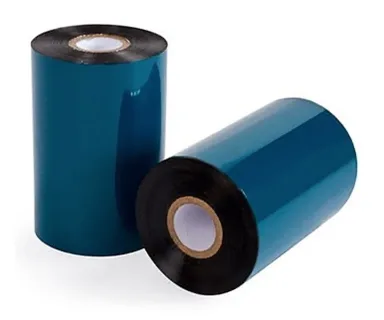Choosing the Right Wax Resin Thermal Transfer Ribbon

The tools you choose can make all the difference when it comes to labeling. One of those essential tools is the Wax Resin Thermal Transfer Ribbon. But what exactly makes this ribbon stand out? Its unique blend of wax and resin offers a balance that caters to various printing needs while ensuring durability and quality. As businesses look for efficient solutions, understanding how to select the correct ribbon becomes crucial. Whether managing inventory in a warehouse or crafting labels for retail products, making an informed decision will enhance your labelling experience. Let’s dive into everything you need to know about choosing the perfect Wax-Resin Thermal Transfer Ribbon for your specific requirements!
What Is a Wax-Resin Thermal Transfer Ribbon?
A Wax-Resin Thermal Transfer Ribbon is a specialized product used in label printing. It combines the benefits of both wax and resin, making it suitable for various applications. This ribbon type is designed for thermal transfer printers, where heat transfers ink from the ribbon onto a label or substrate.
The composition typically features a wax base mixed with resin additives. This combination improves durability compared to standard wax ribbons while maintaining smooth print quality. As a result, labels printed with wax-resin ribbons are more resistant to scratches and smudges.
Businesses often choose this type for industries that require high-quality prints that can withstand challenging conditions. Whether labelling products for retail or shipping items in harsher environments, these ribbons offer versatility and reliability without compromising clarity or detail.
Key Differences Between Wax, Resin, and Wax Resin Ribbons
Wax ribbons are ideal for everyday labelling applications. They provide excellent print quality on various paper labels and are perfect for indoor use where durability is not as critical. Their lower melting point makes them easy to work with but can smudge or fade when exposed to heat or moisture.
Resin ribbons, on the other hand, offer superior durability and resistance against chemicals and fading. They're designed for extreme environments, making them suitable for outdoor labels or products that may encounter rough handling. The downside is that they tend to be more expensive than wax options.
Wax resin ribbons combine the best features of both types. They deliver good print quality while offering better durability than pure wax ribbons. This versatility makes them an ideal choice when you need strong prints that can withstand some exposure without breaking the bank.
Factors to Consider for Label Durability and Quality
Label durability and quality are crucial when selecting a Wax-Resin Thermal Transfer Ribbon. Begin by examining the environment where labels will be used. Factors like exposure to moisture, chemicals, or extreme temperatures can significantly affect the longevity of your labels.
Next, consider the materials involved in your labelling process. The ribbon should match well with your labels' substrate and adhesive. This compatibility ensures that prints adhere properly while resisting smudging and fading.
Evaluate your printer's print speed and resolution settings. Higher speeds may compromise print quality if they are not matched appropriately with ribbon specifications. Balancing these factors allows for sharp images and text that match everyday wear and tear.
Compatibility with Label Materials and Printers
Choosing the right Wax-Resin Thermal Transfer Ribbon requires examining compatibility with label materials and printers. Different materials, such as paper, polyester, or vinyl, react uniquely with various ribbons. It’s crucial to ensure that your selected ribbon is designed for the specific substrate you will use.
Printers also play a significant role in this equation. Not all printers are compatible with every type of ribbon. To avoid printing issues, make sure to check manufacturer specifications when selecting a ribbon for your printer model.
Using incompatible combinations can lead to smudging or fading labels, which could negatively impact business operations. Therefore, taking the time to research and test different combinations can save time and resources down the line.
Environmental Impact and Sustainability Considerations
As businesses increasingly focus on sustainability, choosing labelling materials becomes crucial. Wax-Resin Thermal Transfer Ribbons are often favoured for their balanced performance and lower environmental impact compared to other ribbon types. They typically contain fewer harmful chemicals, making them safer for users and the environment.
Many manufacturers now prioritize eco-friendly practices in producing wax resin ribbons. This includes sourcing raw materials responsibly and minimizing waste during production. Opting for these ribbons can align your labelling processes with broader sustainability goals while ensuring quality output.
Moreover, recycling programs are becoming more common in the industry. Some companies offer take-back initiatives for used thermal transfer ribbons, reducing landfill contributions and promoting circular economy principles. Choosing a wax resin ribbon that supports these efforts reflects a commitment to sustainable business practices while maintaining label quality.
Cost-Effective Options for High-Volume Printing
Managing costs while maintaining quality is paramount for businesses engaging in high-volume labelling. Selecting the right Wax-Resin Thermal Transfer Ribbon can significantly impact operational efficiency and expenditure. Here's a breakdown of cost-effective options tailored for high-volume printing:
Extended Length Ribbons
These ribbons offer more prints per roll, reducing the frequency of roll changes and minimizing downtime, thus lowering labour costs and increasing overall output.
Wider Ribbon Formats
Using wider ribbons can optimize the printing of multiple labels simultaneously, increasing throughput and decreasing the number of required print cycles.
Bulk Purchasing Discounts
Negotiating bulk purchase agreements with ribbon suppliers can lead to substantial cost savings per unit, especially for consistent, high-volume needs.
Optimized Ribbon Formulation
Selecting wax resin blends for high-speed printing minimizes ribbon consumption and print head wear, extending equipment life and reducing replacement costs.
Compatible Ribbon and Label Matching
Ensuring proper matching of ribbon and label materials reduces waste from poor print quality or adhesion, leading to fewer reprints and lower material expenses.
Common Applications of Wax Resin Thermal Transfer Ribbon
Wax Resin Thermal Transfer Ribbon are incredibly versatile and suitable for various applications. Industries such as retail and logistics commonly use these ribbons to create high-quality labels that withstand multiple environments. They’re perfect for product labelling, shipping labels, and barcodes.
In the healthcare sector, wax resin ribbons provide durable labels that remain legible even when exposed to moisture or chemicals. This is crucial for medication packaging and patient identification, where clarity and longevity matter most.
Additionally, manufacturing companies rely on Wax-Resin Thermal Transfer Ribbons to produce warnings and safety labels. Their resistance to scratching ensures important information stays visible throughout the product’s lifecycle. Whether you need short-term tags or long-lasting identifiers, these ribbons deliver reliability across sectors.
Tips for Proper Storage and Handling of Ribbons
Proper Wax-Resin Thermal Transfer Ribbon storage is crucial for maintaining their quality. Store them in a cool, dry place away from direct sunlight. Excessive heat or humidity can cause the ribbons to become brittle or lose adhesion properties.
Handle the ribbons with care to avoid any damage. Always hold them by the core and never touch the surface where printing occurs. This prevents fingerprints or oils from contaminating the ribbon, ensuring optimal performance during printing.
Keep ribbons in their original packaging when not in use to protect them from dust and environmental factors. Avoid stacking heavy objects on top of stored boxes, as this can create pressure that affects ribbon integrity over time. Prioritizing proper storage extends your ribbon's lifespan and enhances print quality.
Conclusion
Choosing the right Wax Resin Thermal Transfer Ribbon can significantly impact your labelling projects. A thoughtful selection enhances label durability and maintains print quality over time. It's essential to evaluate your specific needs, including the materials you're working with and the printers you use. This tailored approach ensures that your labels withstand various conditions while looking sharp. Don't overlook cost-effectiveness, too. You can achieve excellent results without straining your budget by considering high-volume printing options. The right ribbon makes all the difference in creating professional labels that meet industry standards and expectations.
FAQs
Understanding the nuances of a Wax-Resin Thermal Transfer Ribbon can help you make informed decisions for your labelling needs. Here are five frequently asked questions to clarify essential aspects:
What is a Wax Resin Thermal Transfer Ribbon?
A Wax Resin Thermal Transfer Ribbon combines wax and resin properties, offering durability and versatility. It produces high-quality images on various materials while being resistant to smudging.
How do I choose between wax, resin, or wax-resin ribbons?
Your choice depends on the specific application. Wax ribbons are ideal for general labels; resin offers excellent durability against harsh conditions, while wax resin balances quality and performance.
Can I use a wax resin ribbon with any printer?
Not all printers are compatible with every type of ribbon. Ensure your thermal transfer printer supports the specific ribbon type you wish to use.
Are there eco-friendly options available in thermal transfer ribbons?
Yes, many manufacturers are focusing on sustainability by producing environmentally friendly options. Look for products made from recycled materials or those designed for reduced environmental impact.
How should I store my thermal transfer ribbons?
Store them in a cool, dry place away from direct sunlight and extreme temperatures. Proper storage prolongs their life and maintains print quality when you're ready to use them again.
|
Related Business Listings |





